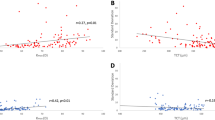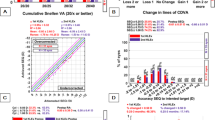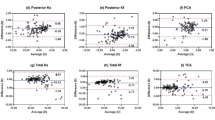Abstract
Objectives
We aimed (1) to assess the repeatability of Total Keratometry (TK) and standard keratometry (K) measurements, as provided by the IOLMaster 700 (Carl Zeiss Meditec), and (2) to compare the corneal astigmatism measured by TK to the total corneal astigmatism (TCA) measured by a Scheimpflug camera (Pentacam AXL, Oculus).
Methods
Two groups of patients were prospectively enrolled: Group A included previously unoperated eyes undergoing cataract surgery, and Group B eyes with previous myopic corneal excimer laser surgery. TK and K were measured three times by the same examiner. Repeatability was assessed based on the within-subject standard deviation (Sw), test–retest variability, coefficient of variation and intraclass correlation coefficient (ICC). In Group A, TCA was measured once and compared to TK astigmatism. Vector analysis was performed according to Næser.
Results
In Group A (69 eyes) the mean K and TK were, respectively, 43.14 ± 1.37 D and 43.18 ± 1.37 D. In Group B (51 eyes) the mean K and TK were, respectively, 40.14 ± 2.20 D and 39.71 ± 2.35 D. The repeatability of the average K and TK was high (Sw < 0.10D). All measurements revealed an ICC > 0.9. For most measurements the variance of K and TK did not show any statistically significant difference either within groups or between groups. Vectors KP(45) were significantly different between TK astigmatism and TCA.
Conclusions
TK measurements offer high repeatability in unoperated and post-excimer laser surgery eyes. TK astigmatism and TCA measurements could not be considered interchangeable.
Similar content being viewed by others
Log in or create a free account to read this content
Gain free access to this article, as well as selected content from this journal and more on nature.com
or
References
Further Reading
Gutmark R, Guyton DL. Origins of the keratometer and its evolving role in ophthalmology. Surv Ophthalmol. 2010;55:481–97.
Savini G, Hoffer KJ, Schiano-Lomoriello D, Ducoli P. Simulated keratometry versus total corneal power by ray tracing: a comparison in prediction accuracy of intraocular lens power. Cornea. 2017;36:1368–72.
Savini G, Barboni P, Carbonelli M, Hoffer KJ. Accuracy of corneal power measurements by a new Scheimpflug camera combined with Placido-disk corneal topography for intraocular lens power calculation in unoperated eyes. J Cataract Refract Surg. 2012;38:787–92.
Savini G, Barboni P, Carbonelli M, Hoffer KJ. Comparison of methods to measure corneal power for intraocular lens power calculation using a rotating Scheimpflug camera. J Cataract Refract Surg. 2013;39:598–604.
Saad E, Shammas MC, Shammas HJ. Scheimpflug corneal power measurements for intraocular lens power calculation in cataract surgery. Am J Ophthalmol. 2013;156:460–7.
Næser K, Savini G, Bregnhøj JF. Corneal powers measured with a rotating Scheimpflug camera. Br J Ophthalmol. 2016;100:1196–1200.
Shirayama M, Wang L, Koch DD, Weikert MP. Comparison of accuracy of intraocular lens calculations using automated keratometry, a Placido- based corneal topographer, and a combined Placido-based and dual Scheimpflug corneal topographer. Cornea. 2010;29:1136–8.
Savini G, Barboni P, Carbonelli M, Hoffer KJ. Accuracy of a dual Scheimpflug analyzer and a corneal topography system for intraocular lens power calculation in unoperated eyes. J Cataract Refract Surg. 2011;37:72–6.
Srivannaboon S, Chirapapaisan C. Comparison of refractive outcomes using conventional keratometry or total keratometry for IOL power calculation in cataract surgery. Graefes Arch Clin Exp Ophthalmol. 2019;257:2677–82.
LaHood BR, Goggin M, Beheregaray S, Andrew NH, Esterman A. Comparing total keratometry measurement on the IOLMaster 700 with Goggin nomogram adjusted anterior keratometry. J Refract Surg. 2018;34:521–6.
Fabian E, Wehner W. Prediction accuracy of total keratometry compared to standard keratometry using different intraocular lens power formulas. J Refract Surg. 2019;35:362–8.
Wang L, Spektor T, de Souza RG, Koch DD. Evaluation of total keratometry and its accuracy for intraocular lens power calculation in eyes after corneal refractive surgery. J Cataract Refract Surg. 2019;45:1416–21.
Ruiz-Mesa R, Abengózar-Vela A, Ruiz-Santos M. Comparison of a new Scheimpflug imaging combined with partial coherence interferometry biometer and a low-coherence reflectometry biometer. J Cataract Refract Surg. 2017;43:1406–12.
Næser K. Assessment and statistics of surgically induced astigmatism. Acta Ophthalmol Scand. 2008;86:1–28.
Ventura BV, Al-Mohtaseb Z, Wang L, Koch DD, Weikert MP. Repeatability and comparability of corneal power and corneal astigmatism obtained from a point-source color light-emitting diode topographer, a Placido-based corneal topographer, and a low-coherence reflectometer. J Cataract Refract Surg. 2015;41:2242–50.
Kobashi H, Kamiya K, Igarashi A, Ishii R, Sato N, Wang G, et al. Comparison of corneal power, corneal astigmatism, and axis location in normal eyes obtained from an autokeratometer and a corneal topographer. J Cataract Refract Surg. 2012;38:648–54.
Kim EJ, Montes de Oca I, Wang L, Weikert MP, Koch DD, Khandelwal SS. Repeatability of posterior and total corneal curvature measurements with a dual Scheimpflug–Placido tomographer. J Cataract Refract Surg. 2015;41:2731–8.
International Organization for Standardization. Accuracy (trueness and precision) of measurement methods and results. Part 1. General principles and definitions. Geneva: ISO; 1994. (ISO 5725–1:1994).
Savini G, Schiano-Lomoriello D, Hoffer KJ. Repeatability of automatic measurements by a new anterior segment optical coherence tomographer combined with Placido topography and agreement with 2 Scheimpflug cameras. J Cataract Refract Surg. 2018;44:471–8.
Bland JM, Altman DG. Statistical methods for assessing agreement between two methods of clinical measurement. Lancet. 1986;1:307–10.
Budenz DL, Fredette MJ, Feuer WJ. Reproducibility of peripapillary retinal nerve fiber thickness measurements with stratus OCT in glaucomatous eyes. Ophthalmology. 2008;115:661–6.
McGraw KO, Wong SP. Forming inferences about some intraclass correlation coefficients. Psychol Methods. 1996;1:30–46.
McAlinden C, Khadka J, Pesudovs K. Precision (repeatability and reproducibility) studies and sample-size calculation. J Cataract Refract Surg. 2015;41:2598–604.
Aramberri J, Araz L, Garcia A, Illarramendi I, Olmos J, Oyanarte I, et al. Dual versus single Scheimpflug camera for anterior segment analysis: precision and agreement. J Cataract Refract Surg. 2012;38:1934–49.
Shirayama M, Wang L, Weikert MP, Koch DD. Comparison of corneal powers obtained from 4 different devices. Am J Ophthalmol. 2009;148:528–35.
Savini G, Barboni P, Carbonelli M, Hoffer KJ. Repeatability of automatic measurements by a new Scheimpflug camera combined with Placido topography. J Cataract Refract Surg. 2011;37:1809–16.
Hoffer KJ. Intraocular lens power calculation after previous laser refractive surgery. J Cataract Refract Surg. 2009;35:759–65.
Shajari M, Sonntag R, Ramsauer M, Kreutzer T, Vounotrypidis E, Kohnen T, et al. Evaluation of total corneal power measurements with a new optical biometer. J Cataract Refract Surg. 2020;46:675–81.
Savini G, Negishi K, Hoffer KJ, Schiano, Lomoriello D. Refractive outcomes of intraocular lens power calculation using different corneal power measurements with a new optical biometer. J Cataract Refract Surg. 2018;44:701–8.
Jung S, Chin HS, Kim NR, Lee KW, Jung JW. Comparison of repeatability and agreement between swept-source optical biometry and dual-Scheimpflug topography. J Ophthalmol. 2017;2017:1516395.
Lu W, Li Y, Savini G, Song B, Hu Q, Wang Q, et al. Comparison of anterior segment measurements obtained using a swept-source optical coherence tomography biometer and a Scheimpflug-Placido tomographer. J Cataract Refract Surg. 2019;45:298–304.
Kurian M, Negalur N, Das S, Puttaiah NK, Haria D, TS J, et al. Biometry with a new swept-source optical coherence tomography biometer: repeatability and agreement with an optical low-coherence reflectometry device. J Cataract Refract Surg. 2016;42:577–81.
Huang J, Savini G, Wu F, Yu X, Yang J, Yu A, et al. Repeatability and reproducibility of ocular biometry using a new noncontact optical low-coherence interferometer. J Cataract Refract Surg. 2015;41:2223–41.
Huang J, Savini G, Hoffer KJ, Chen H, Lu W, Hu Q, et al. Repeatability and interobserver reproducibility of a new optical biometer based on swept-source optical coherence tomography and comparison with IOLMaster. Br J Ophthalmol. 2017;101:493–8.
Koch DD, Ali SF, Weikert MP, Shirayama M, Jenkins R, Wang L. Contribution of posterior corneal astigmatism to total corneal astigmatism. J Cataract Refract Surg. 2012;38:2080–7.
Tonn B, Klaproth OK, Kohnen T. Anterior surface-based keratometry compared with Scheimpflug tomography-based total corneal astigmatism. Investig Ophthalmol Vis Sci. 2015;56:291–8.
Savini G, Versaci F, Vestri G, Ducoli P, Næser K. Influence of posterior corneal astigmatism on total corneal astigmatism in eyes with moderate to high astigmatism. J Cataract Refract Surg. 2014;40:1645–53.
Özyol P, Özyol E. Agreement between swept-source optical biometry and Scheimpflug-based topography measurements of anterior segment parameters. Am J Ophthalmol. 2016;169:73–78.
Shajari M, Cremonese C, Petermann K, Singh P, Müller M, Kohnen T. Comparison of axial length, corneal curvature, and anterior chamber depth measurements of 2 recently introduced devices to a known biometer. Am J Ophthalmol. 2017;178:58–64.
Other cited material
Dupont WD, Plummer WD Jr. PS: Power and Sample Size Calculation, version 3.0, 2009. Nashville, TN, Department of Biostatistics, Vanderbilt University, 2012. Available at: http://biostat.mc.vanderbilt.edu/twiki/bin/view/Main/PowerSampleSize. Accessed March 14th, 2020.
Acknowledgements
Funding
The contribution of I.R.C.C.S. - G.B. Bietti Foundation was supported by Fondazione Roma and the Italian Ministry of Health
Author information
Authors and Affiliations
Corresponding author
Ethics declarations
Conflict of interest
KJH licenses the registered trademark name Hoffer® to ensure accurate programming of his formulas to Carl Zeiss-Meditec (IOLMasters), Haag-Streit (LenStar/EyeStar), Heidelberg Engineering (Anterion), Oculus (Pentacam AXL), Movu (Argos), Nidek (AL-Scan), Oculus (Pentacam AXL), Tomey (OA-2000), Topcon EU/VisiaImaging (Aladdin), Ziemer (Galilei G6) and all A-scan biometer manufacturers. GS is a consultant to CSO and has received personal fees from Alcon, Oculus, and Zeiss. For the remaining authors none were declared.
Additional information
Publisher’s note Springer Nature remains neutral with regard to jurisdictional claims in published maps and institutional affiliations.
Rights and permissions
About this article
Cite this article
Savini, G., Taroni, L., Schiano-Lomoriello, D. et al. Repeatability of total Keratometry and standard Keratometry by the IOLMaster 700 and comparison to total corneal astigmatism by Scheimpflug imaging. Eye 35, 307–315 (2021). https://doi.org/10.1038/s41433-020-01245-8
Received:
Revised:
Accepted:
Published:
Issue date:
DOI: https://doi.org/10.1038/s41433-020-01245-8
This article is cited by
-
Keratometry repeatability in healthy and post-refractive surgery eyes: a comparison of two swept-source devices
Graefe's Archive for Clinical and Experimental Ophthalmology (2025)
-
Longitudinal changes in ocular biometry and their effect on intraocular lens power calculation accuracy in cataract patients
Graefe's Archive for Clinical and Experimental Ophthalmology (2025)
-
Analysis of differences between keratometric astigmatism and total corneal astigmatism measured by IOLMaster 700
International Ophthalmology (2025)
-
The VRF-L and VRF-GL IOL power calculation methods after radial keratotomy
Eye (2024)
-
Lower refractive prediction accuracy of total keratometry using intraocular lens formulas loaded onto a swept-source optical biometer
Graefe's Archive for Clinical and Experimental Ophthalmology (2023)



